Advanced Data Mining: Cardiac Arrhythmia Classification Project
VerifiedAdded on 2023/06/10
|10
|4822
|461
Project
AI Summary
This project focuses on data mining techniques for cardiac arrhythmia classification, aiming to distinguish between the presence and absence of cardiac arrhythmia and classify it into one of 16 groups. It leverages methods such as KNN, Naive Bayes, SVM, Gradient Boosting, Model Tree, and Random Forest, using the CRISP-DM methodology. The project analyzes a dataset with 279 attributes, including linear and nominal values, to decrease differences among cardiologists and program classifications. The literature review provides a background on various data mining methods, and the results indicate an accuracy of 77.3% for heartbeat classification. The project concludes with a discussion of future work involving online detection methods for improved accuracy and efficiency. Desklib provides access to this and other solved assignments for students.
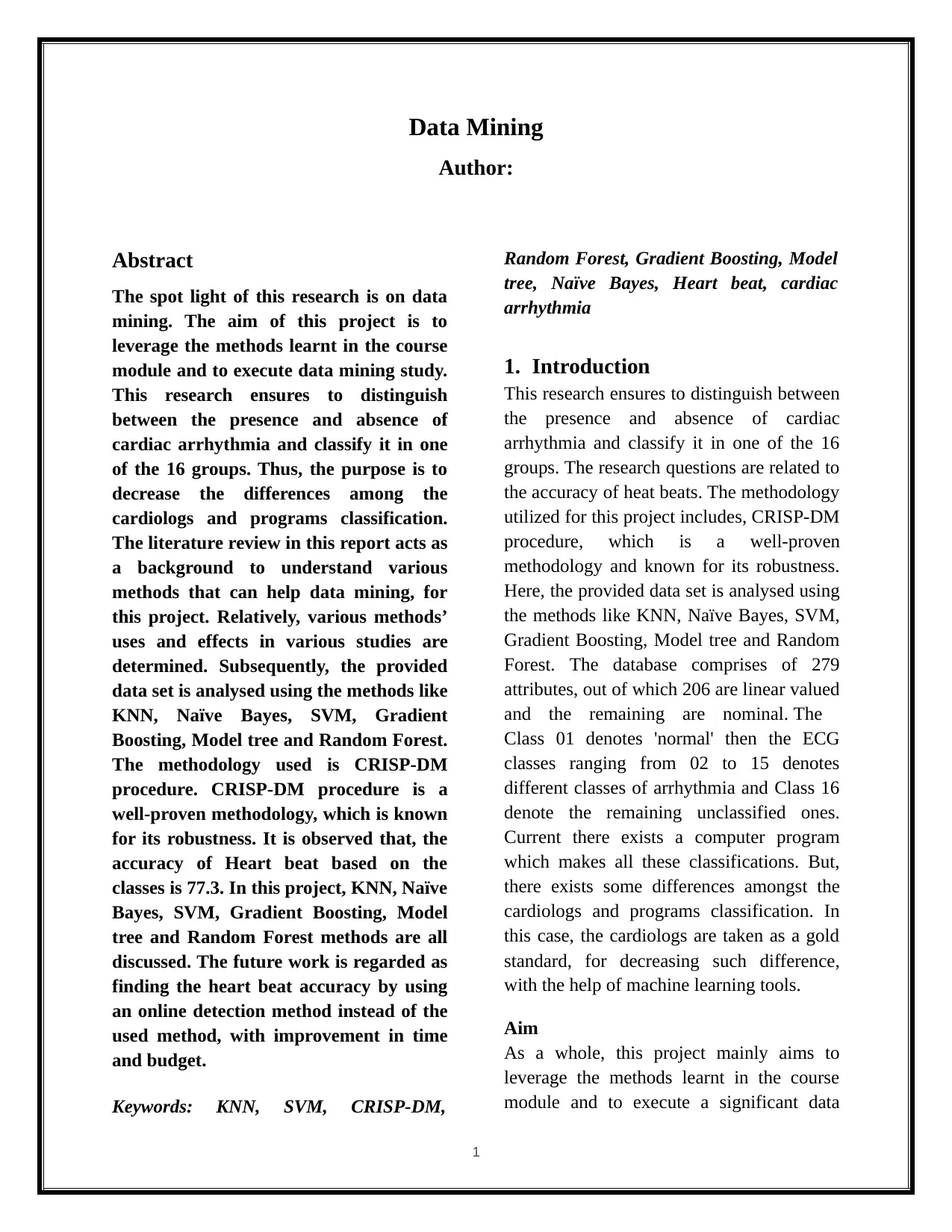
Data Mining
Author:
Abstract
The spot light of this research is on data
mining. The aim of this project is to
leverage the methods learnt in the course
module and to execute data mining study.
This research ensures to distinguish
between the presence and absence of
cardiac arrhythmia and classify it in one
of the 16 groups. Thus, the purpose is to
decrease the differences among the
cardiologs and programs classification.
The literature review in this report acts as
a background to understand various
methods that can help data mining, for
this project. Relatively, various methods’
uses and effects in various studies are
determined. Subsequently, the provided
data set is analysed using the methods like
KNN, Naïve Bayes, SVM, Gradient
Boosting, Model tree and Random Forest.
The methodology used is CRISP-DM
procedure. CRISP-DM procedure is a
well-proven methodology, which is known
for its robustness. It is observed that, the
accuracy of Heart beat based on the
classes is 77.3. In this project, KNN, Naïve
Bayes, SVM, Gradient Boosting, Model
tree and Random Forest methods are all
discussed. The future work is regarded as
finding the heart beat accuracy by using
an online detection method instead of the
used method, with improvement in time
and budget.
Keywords: KNN, SVM, CRISP-DM,
Random Forest, Gradient Boosting, Model
tree, Naïve Bayes, Heart beat, cardiac
arrhythmia
1. Introduction
This research ensures to distinguish between
the presence and absence of cardiac
arrhythmia and classify it in one of the 16
groups. The research questions are related to
the accuracy of heat beats. The methodology
utilized for this project includes, CRISP-DM
procedure, which is a well-proven
methodology and known for its robustness.
Here, the provided data set is analysed using
the methods like KNN, Naïve Bayes, SVM,
Gradient Boosting, Model tree and Random
Forest. The database comprises of 279
attributes, out of which 206 are linear valued
and the remaining are nominal. The
Class 01 denotes 'normal' then the ECG
classes ranging from 02 to 15 denotes
different classes of arrhythmia and Class 16
denote the remaining unclassified ones.
Current there exists a computer program
which makes all these classifications. But,
there exists some differences amongst the
cardiologs and programs classification. In
this case, the cardiologs are taken as a gold
standard, for decreasing such difference,
with the help of machine learning tools.
Aim
As a whole, this project mainly aims to
leverage the methods learnt in the course
module and to execute a significant data
1
Author:
Abstract
The spot light of this research is on data
mining. The aim of this project is to
leverage the methods learnt in the course
module and to execute data mining study.
This research ensures to distinguish
between the presence and absence of
cardiac arrhythmia and classify it in one
of the 16 groups. Thus, the purpose is to
decrease the differences among the
cardiologs and programs classification.
The literature review in this report acts as
a background to understand various
methods that can help data mining, for
this project. Relatively, various methods’
uses and effects in various studies are
determined. Subsequently, the provided
data set is analysed using the methods like
KNN, Naïve Bayes, SVM, Gradient
Boosting, Model tree and Random Forest.
The methodology used is CRISP-DM
procedure. CRISP-DM procedure is a
well-proven methodology, which is known
for its robustness. It is observed that, the
accuracy of Heart beat based on the
classes is 77.3. In this project, KNN, Naïve
Bayes, SVM, Gradient Boosting, Model
tree and Random Forest methods are all
discussed. The future work is regarded as
finding the heart beat accuracy by using
an online detection method instead of the
used method, with improvement in time
and budget.
Keywords: KNN, SVM, CRISP-DM,
Random Forest, Gradient Boosting, Model
tree, Naïve Bayes, Heart beat, cardiac
arrhythmia
1. Introduction
This research ensures to distinguish between
the presence and absence of cardiac
arrhythmia and classify it in one of the 16
groups. The research questions are related to
the accuracy of heat beats. The methodology
utilized for this project includes, CRISP-DM
procedure, which is a well-proven
methodology and known for its robustness.
Here, the provided data set is analysed using
the methods like KNN, Naïve Bayes, SVM,
Gradient Boosting, Model tree and Random
Forest. The database comprises of 279
attributes, out of which 206 are linear valued
and the remaining are nominal. The
Class 01 denotes 'normal' then the ECG
classes ranging from 02 to 15 denotes
different classes of arrhythmia and Class 16
denote the remaining unclassified ones.
Current there exists a computer program
which makes all these classifications. But,
there exists some differences amongst the
cardiologs and programs classification. In
this case, the cardiologs are taken as a gold
standard, for decreasing such difference,
with the help of machine learning tools.
Aim
As a whole, this project mainly aims to
leverage the methods learnt in the course
module and to execute a significant data
1
Paraphrase This Document
Need a fresh take? Get an instant paraphrase of this document with our AI Paraphraser
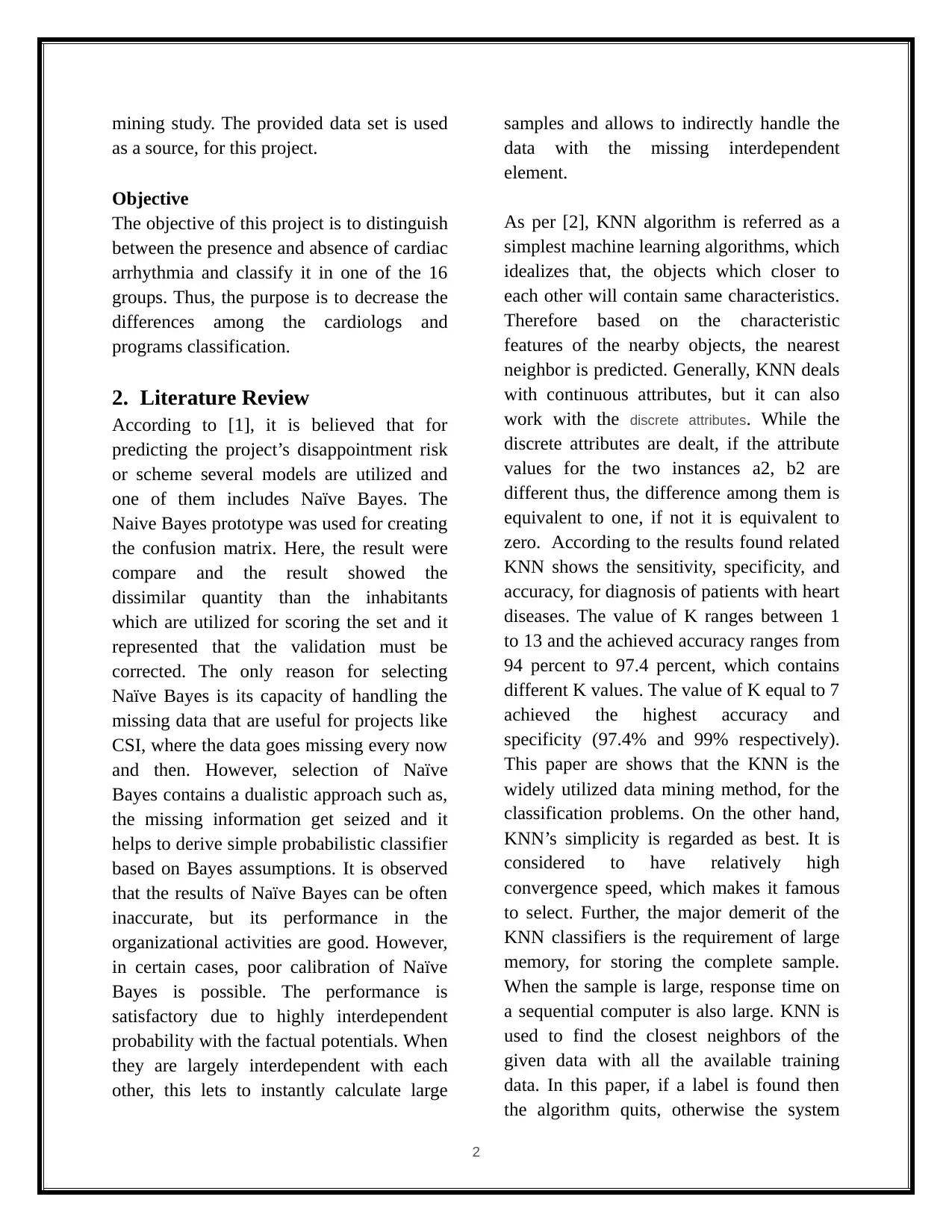
mining study. The provided data set is used
as a source, for this project.
Objective
The objective of this project is to distinguish
between the presence and absence of cardiac
arrhythmia and classify it in one of the 16
groups. Thus, the purpose is to decrease the
differences among the cardiologs and
programs classification.
2. Literature Review
According to [1], it is believed that for
predicting the project’s disappointment risk
or scheme several models are utilized and
one of them includes Naïve Bayes. The
Naive Bayes prototype was used for creating
the confusion matrix. Here, the result were
compare and the result showed the
dissimilar quantity than the inhabitants
which are utilized for scoring the set and it
represented that the validation must be
corrected. The only reason for selecting
Naïve Bayes is its capacity of handling the
missing data that are useful for projects like
CSI, where the data goes missing every now
and then. However, selection of Naïve
Bayes contains a dualistic approach such as,
the missing information get seized and it
helps to derive simple probabilistic classifier
based on Bayes assumptions. It is observed
that the results of Naïve Bayes can be often
inaccurate, but its performance in the
organizational activities are good. However,
in certain cases, poor calibration of Naïve
Bayes is possible. The performance is
satisfactory due to highly interdependent
probability with the factual potentials. When
they are largely interdependent with each
other, this lets to instantly calculate large
samples and allows to indirectly handle the
data with the missing interdependent
element.
As per [2], KNN algorithm is referred as a
simplest machine learning algorithms, which
idealizes that, the objects which closer to
each other will contain same characteristics.
Therefore based on the characteristic
features of the nearby objects, the nearest
neighbor is predicted. Generally, KNN deals
with continuous attributes, but it can also
work with the discrete attributes. While the
discrete attributes are dealt, if the attribute
values for the two instances a2, b2 are
different thus, the difference among them is
equivalent to one, if not it is equivalent to
zero. According to the results found related
KNN shows the sensitivity, specificity, and
accuracy, for diagnosis of patients with heart
diseases. The value of K ranges between 1
to 13 and the achieved accuracy ranges from
94 percent to 97.4 percent, which contains
different K values. The value of K equal to 7
achieved the highest accuracy and
specificity (97.4% and 99% respectively).
This paper are shows that the KNN is the
widely utilized data mining method, for the
classification problems. On the other hand,
KNN’s simplicity is regarded as best. It is
considered to have relatively high
convergence speed, which makes it famous
to select. Further, the major demerit of the
KNN classifiers is the requirement of large
memory, for storing the complete sample.
When the sample is large, response time on
a sequential computer is also large. KNN is
used to find the closest neighbors of the
given data with all the available training
data. In this paper, if a label is found then
the algorithm quits, otherwise the system
2
as a source, for this project.
Objective
The objective of this project is to distinguish
between the presence and absence of cardiac
arrhythmia and classify it in one of the 16
groups. Thus, the purpose is to decrease the
differences among the cardiologs and
programs classification.
2. Literature Review
According to [1], it is believed that for
predicting the project’s disappointment risk
or scheme several models are utilized and
one of them includes Naïve Bayes. The
Naive Bayes prototype was used for creating
the confusion matrix. Here, the result were
compare and the result showed the
dissimilar quantity than the inhabitants
which are utilized for scoring the set and it
represented that the validation must be
corrected. The only reason for selecting
Naïve Bayes is its capacity of handling the
missing data that are useful for projects like
CSI, where the data goes missing every now
and then. However, selection of Naïve
Bayes contains a dualistic approach such as,
the missing information get seized and it
helps to derive simple probabilistic classifier
based on Bayes assumptions. It is observed
that the results of Naïve Bayes can be often
inaccurate, but its performance in the
organizational activities are good. However,
in certain cases, poor calibration of Naïve
Bayes is possible. The performance is
satisfactory due to highly interdependent
probability with the factual potentials. When
they are largely interdependent with each
other, this lets to instantly calculate large
samples and allows to indirectly handle the
data with the missing interdependent
element.
As per [2], KNN algorithm is referred as a
simplest machine learning algorithms, which
idealizes that, the objects which closer to
each other will contain same characteristics.
Therefore based on the characteristic
features of the nearby objects, the nearest
neighbor is predicted. Generally, KNN deals
with continuous attributes, but it can also
work with the discrete attributes. While the
discrete attributes are dealt, if the attribute
values for the two instances a2, b2 are
different thus, the difference among them is
equivalent to one, if not it is equivalent to
zero. According to the results found related
KNN shows the sensitivity, specificity, and
accuracy, for diagnosis of patients with heart
diseases. The value of K ranges between 1
to 13 and the achieved accuracy ranges from
94 percent to 97.4 percent, which contains
different K values. The value of K equal to 7
achieved the highest accuracy and
specificity (97.4% and 99% respectively).
This paper are shows that the KNN is the
widely utilized data mining method, for the
classification problems. On the other hand,
KNN’s simplicity is regarded as best. It is
considered to have relatively high
convergence speed, which makes it famous
to select. Further, the major demerit of the
KNN classifiers is the requirement of large
memory, for storing the complete sample.
When the sample is large, response time on
a sequential computer is also large. KNN is
used to find the closest neighbors of the
given data with all the available training
data. In this paper, if a label is found then
the algorithm quits, otherwise the system
2
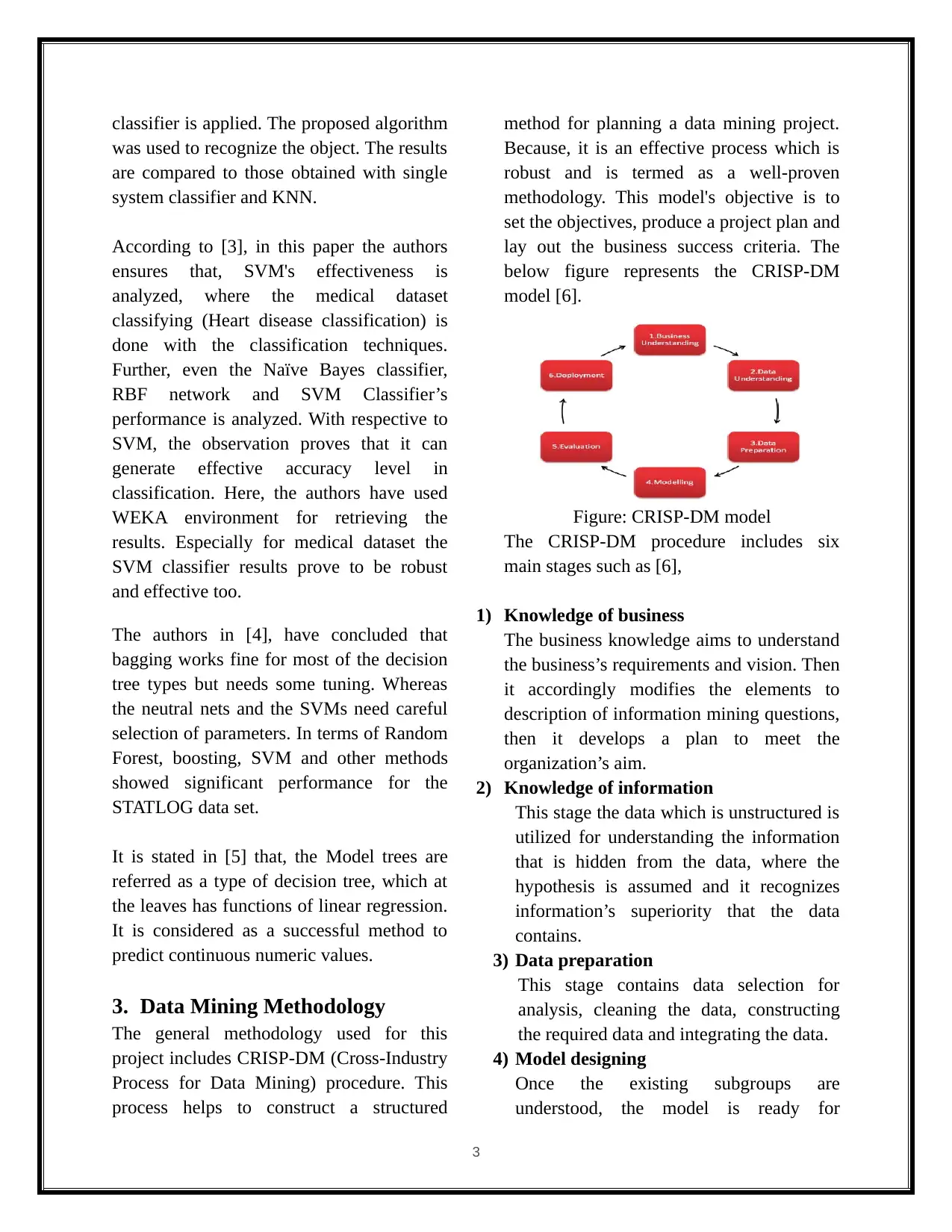
classifier is applied. The proposed algorithm
was used to recognize the object. The results
are compared to those obtained with single
system classifier and KNN.
According to [3], in this paper the authors
ensures that, SVM's effectiveness is
analyzed, where the medical dataset
classifying (Heart disease classification) is
done with the classification techniques.
Further, even the Naïve Bayes classifier,
RBF network and SVM Classifier’s
performance is analyzed. With respective to
SVM, the observation proves that it can
generate effective accuracy level in
classification. Here, the authors have used
WEKA environment for retrieving the
results. Especially for medical dataset the
SVM classifier results prove to be robust
and effective too.
The authors in [4], have concluded that
bagging works fine for most of the decision
tree types but needs some tuning. Whereas
the neutral nets and the SVMs need careful
selection of parameters. In terms of Random
Forest, boosting, SVM and other methods
showed significant performance for the
STATLOG data set.
It is stated in [5] that, the Model trees are
referred as a type of decision tree, which at
the leaves has functions of linear regression.
It is considered as a successful method to
predict continuous numeric values.
3. Data Mining Methodology
The general methodology used for this
project includes CRISP-DM (Cross-Industry
Process for Data Mining) procedure. This
process helps to construct a structured
method for planning a data mining project.
Because, it is an effective process which is
robust and is termed as a well-proven
methodology. This model's objective is to
set the objectives, produce a project plan and
lay out the business success criteria. The
below figure represents the CRISP-DM
model [6].
Figure: CRISP-DM model
The CRISP-DM procedure includes six
main stages such as [6],
1) Knowledge of business
The business knowledge aims to understand
the business’s requirements and vision. Then
it accordingly modifies the elements to
description of information mining questions,
then it develops a plan to meet the
organization’s aim.
2) Knowledge of information
This stage the data which is unstructured is
utilized for understanding the information
that is hidden from the data, where the
hypothesis is assumed and it recognizes
information’s superiority that the data
contains.
3) Data preparation
This stage contains data selection for
analysis, cleaning the data, constructing
the required data and integrating the data.
4) Model designing
Once the existing subgroups are
understood, the model is ready for
3
was used to recognize the object. The results
are compared to those obtained with single
system classifier and KNN.
According to [3], in this paper the authors
ensures that, SVM's effectiveness is
analyzed, where the medical dataset
classifying (Heart disease classification) is
done with the classification techniques.
Further, even the Naïve Bayes classifier,
RBF network and SVM Classifier’s
performance is analyzed. With respective to
SVM, the observation proves that it can
generate effective accuracy level in
classification. Here, the authors have used
WEKA environment for retrieving the
results. Especially for medical dataset the
SVM classifier results prove to be robust
and effective too.
The authors in [4], have concluded that
bagging works fine for most of the decision
tree types but needs some tuning. Whereas
the neutral nets and the SVMs need careful
selection of parameters. In terms of Random
Forest, boosting, SVM and other methods
showed significant performance for the
STATLOG data set.
It is stated in [5] that, the Model trees are
referred as a type of decision tree, which at
the leaves has functions of linear regression.
It is considered as a successful method to
predict continuous numeric values.
3. Data Mining Methodology
The general methodology used for this
project includes CRISP-DM (Cross-Industry
Process for Data Mining) procedure. This
process helps to construct a structured
method for planning a data mining project.
Because, it is an effective process which is
robust and is termed as a well-proven
methodology. This model's objective is to
set the objectives, produce a project plan and
lay out the business success criteria. The
below figure represents the CRISP-DM
model [6].
Figure: CRISP-DM model
The CRISP-DM procedure includes six
main stages such as [6],
1) Knowledge of business
The business knowledge aims to understand
the business’s requirements and vision. Then
it accordingly modifies the elements to
description of information mining questions,
then it develops a plan to meet the
organization’s aim.
2) Knowledge of information
This stage the data which is unstructured is
utilized for understanding the information
that is hidden from the data, where the
hypothesis is assumed and it recognizes
information’s superiority that the data
contains.
3) Data preparation
This stage contains data selection for
analysis, cleaning the data, constructing
the required data and integrating the data.
4) Model designing
Once the existing subgroups are
understood, the model is ready for
3
⊘ This is a preview!⊘
Do you want full access?
Subscribe today to unlock all pages.

Trusted by 1+ million students worldwide
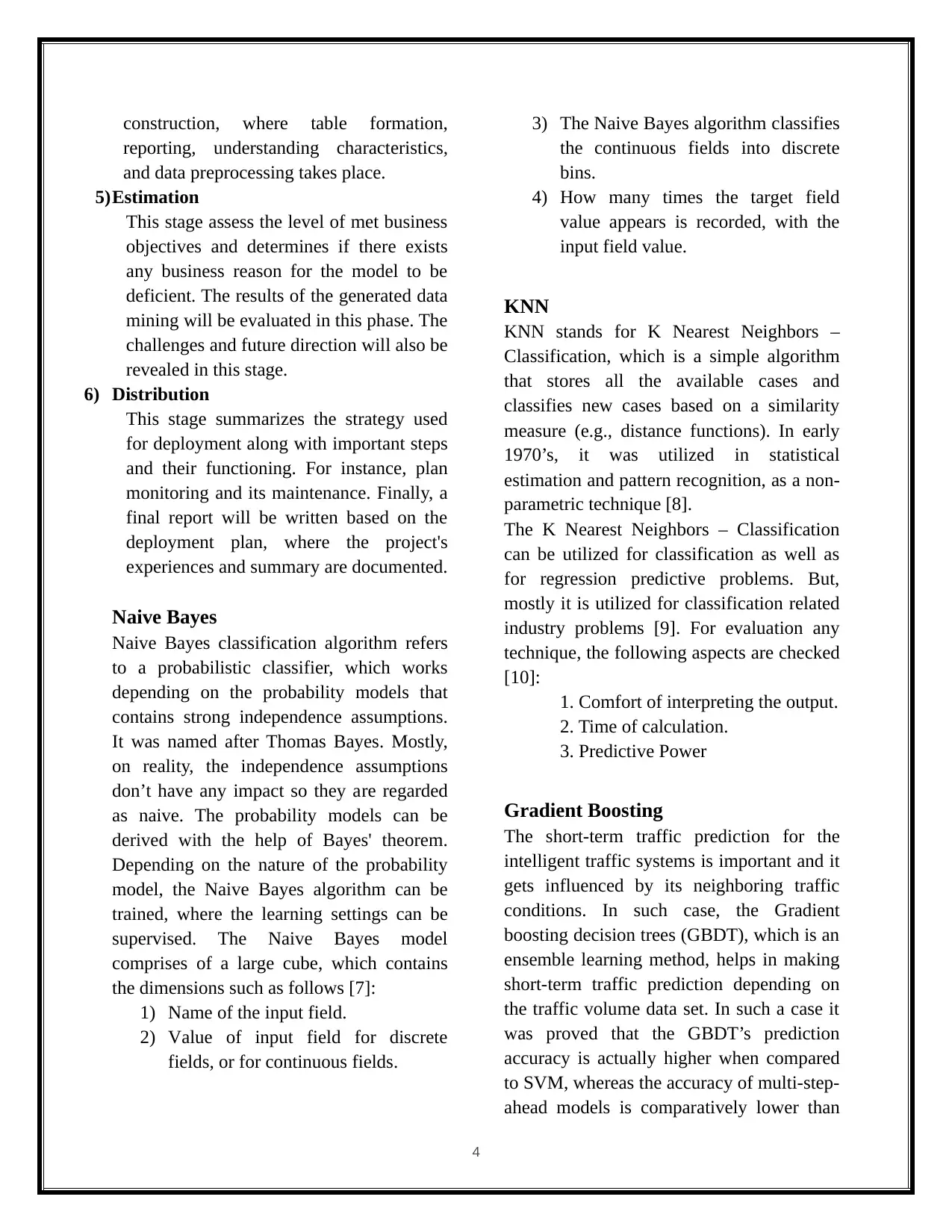
construction, where table formation,
reporting, understanding characteristics,
and data preprocessing takes place.
5)Estimation
This stage assess the level of met business
objectives and determines if there exists
any business reason for the model to be
deficient. The results of the generated data
mining will be evaluated in this phase. The
challenges and future direction will also be
revealed in this stage.
6) Distribution
This stage summarizes the strategy used
for deployment along with important steps
and their functioning. For instance, plan
monitoring and its maintenance. Finally, a
final report will be written based on the
deployment plan, where the project's
experiences and summary are documented.
Naive Bayes
Naive Bayes classification algorithm refers
to a probabilistic classifier, which works
depending on the probability models that
contains strong independence assumptions.
It was named after Thomas Bayes. Mostly,
on reality, the independence assumptions
don’t have any impact so they are regarded
as naive. The probability models can be
derived with the help of Bayes' theorem.
Depending on the nature of the probability
model, the Naive Bayes algorithm can be
trained, where the learning settings can be
supervised. The Naive Bayes model
comprises of a large cube, which contains
the dimensions such as follows [7]:
1) Name of the input field.
2) Value of input field for discrete
fields, or for continuous fields.
3) The Naive Bayes algorithm classifies
the continuous fields into discrete
bins.
4) How many times the target field
value appears is recorded, with the
input field value.
KNN
KNN stands for K Nearest Neighbors –
Classification, which is a simple algorithm
that stores all the available cases and
classifies new cases based on a similarity
measure (e.g., distance functions). In early
1970’s, it was utilized in statistical
estimation and pattern recognition, as a non-
parametric technique [8].
The K Nearest Neighbors – Classification
can be utilized for classification as well as
for regression predictive problems. But,
mostly it is utilized for classification related
industry problems [9]. For evaluation any
technique, the following aspects are checked
[10]:
1. Comfort of interpreting the output.
2. Time of calculation.
3. Predictive Power
Gradient Boosting
The short-term traffic prediction for the
intelligent traffic systems is important and it
gets influenced by its neighboring traffic
conditions. In such case, the Gradient
boosting decision trees (GBDT), which is an
ensemble learning method, helps in making
short-term traffic prediction depending on
the traffic volume data set. In such a case it
was proved that the GBDT’s prediction
accuracy is actually higher when compared
to SVM, whereas the accuracy of multi-step-
ahead models is comparatively lower than
4
reporting, understanding characteristics,
and data preprocessing takes place.
5)Estimation
This stage assess the level of met business
objectives and determines if there exists
any business reason for the model to be
deficient. The results of the generated data
mining will be evaluated in this phase. The
challenges and future direction will also be
revealed in this stage.
6) Distribution
This stage summarizes the strategy used
for deployment along with important steps
and their functioning. For instance, plan
monitoring and its maintenance. Finally, a
final report will be written based on the
deployment plan, where the project's
experiences and summary are documented.
Naive Bayes
Naive Bayes classification algorithm refers
to a probabilistic classifier, which works
depending on the probability models that
contains strong independence assumptions.
It was named after Thomas Bayes. Mostly,
on reality, the independence assumptions
don’t have any impact so they are regarded
as naive. The probability models can be
derived with the help of Bayes' theorem.
Depending on the nature of the probability
model, the Naive Bayes algorithm can be
trained, where the learning settings can be
supervised. The Naive Bayes model
comprises of a large cube, which contains
the dimensions such as follows [7]:
1) Name of the input field.
2) Value of input field for discrete
fields, or for continuous fields.
3) The Naive Bayes algorithm classifies
the continuous fields into discrete
bins.
4) How many times the target field
value appears is recorded, with the
input field value.
KNN
KNN stands for K Nearest Neighbors –
Classification, which is a simple algorithm
that stores all the available cases and
classifies new cases based on a similarity
measure (e.g., distance functions). In early
1970’s, it was utilized in statistical
estimation and pattern recognition, as a non-
parametric technique [8].
The K Nearest Neighbors – Classification
can be utilized for classification as well as
for regression predictive problems. But,
mostly it is utilized for classification related
industry problems [9]. For evaluation any
technique, the following aspects are checked
[10]:
1. Comfort of interpreting the output.
2. Time of calculation.
3. Predictive Power
Gradient Boosting
The short-term traffic prediction for the
intelligent traffic systems is important and it
gets influenced by its neighboring traffic
conditions. In such case, the Gradient
boosting decision trees (GBDT), which is an
ensemble learning method, helps in making
short-term traffic prediction depending on
the traffic volume data set. In such a case it
was proved that the GBDT’s prediction
accuracy is actually higher when compared
to SVM, whereas the accuracy of multi-step-
ahead models is comparatively lower than
4
Paraphrase This Document
Need a fresh take? Get an instant paraphrase of this document with our AI Paraphraser
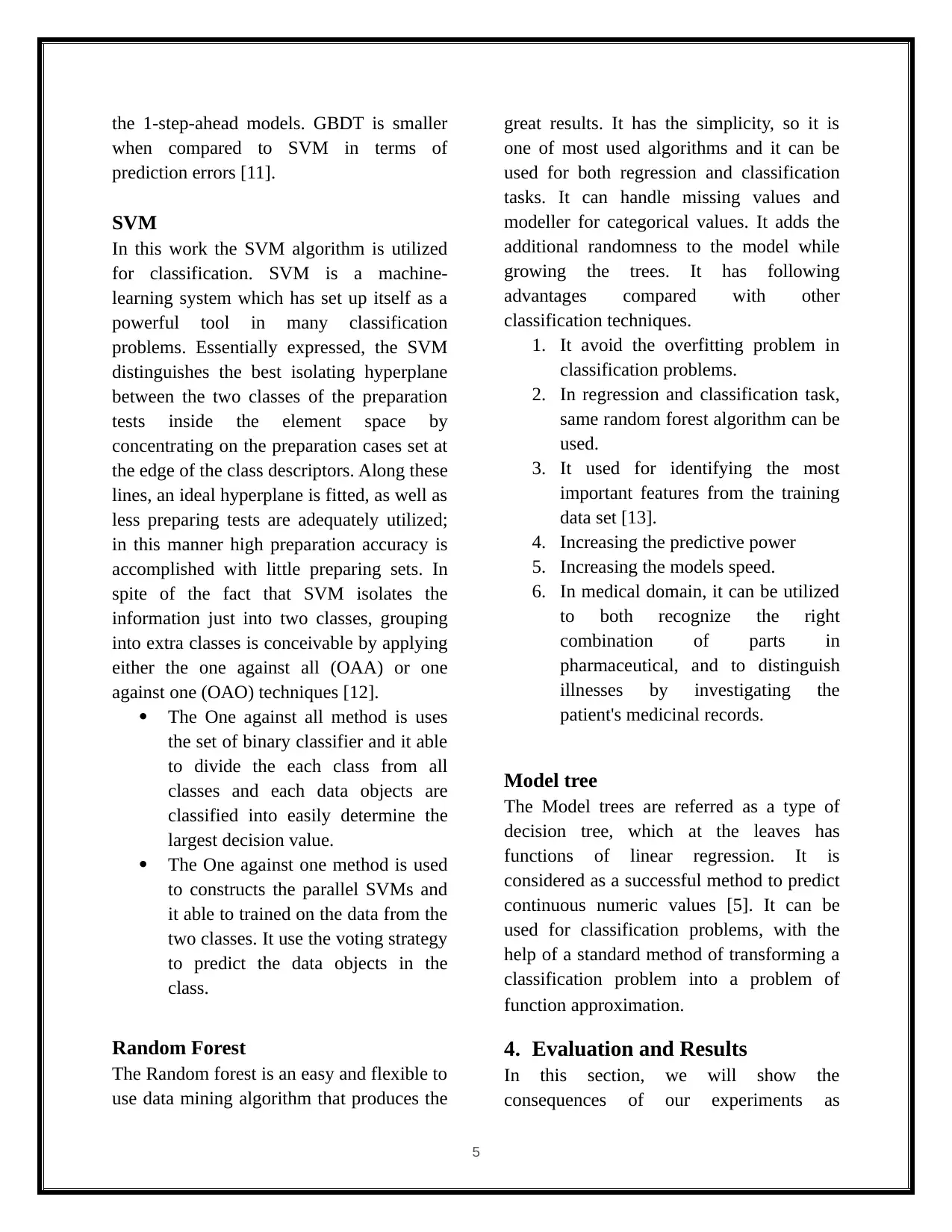
the 1-step-ahead models. GBDT is smaller
when compared to SVM in terms of
prediction errors [11].
SVM
In this work the SVM algorithm is utilized
for classification. SVM is a machine-
learning system which has set up itself as a
powerful tool in many classification
problems. Essentially expressed, the SVM
distinguishes the best isolating hyperplane
between the two classes of the preparation
tests inside the element space by
concentrating on the preparation cases set at
the edge of the class descriptors. Along these
lines, an ideal hyperplane is fitted, as well as
less preparing tests are adequately utilized;
in this manner high preparation accuracy is
accomplished with little preparing sets. In
spite of the fact that SVM isolates the
information just into two classes, grouping
into extra classes is conceivable by applying
either the one against all (OAA) or one
against one (OAO) techniques [12].
The One against all method is uses
the set of binary classifier and it able
to divide the each class from all
classes and each data objects are
classified into easily determine the
largest decision value.
The One against one method is used
to constructs the parallel SVMs and
it able to trained on the data from the
two classes. It use the voting strategy
to predict the data objects in the
class.
Random Forest
The Random forest is an easy and flexible to
use data mining algorithm that produces the
great results. It has the simplicity, so it is
one of most used algorithms and it can be
used for both regression and classification
tasks. It can handle missing values and
modeller for categorical values. It adds the
additional randomness to the model while
growing the trees. It has following
advantages compared with other
classification techniques.
1. It avoid the overfitting problem in
classification problems.
2. In regression and classification task,
same random forest algorithm can be
used.
3. It used for identifying the most
important features from the training
data set [13].
4. Increasing the predictive power
5. Increasing the models speed.
6. In medical domain, it can be utilized
to both recognize the right
combination of parts in
pharmaceutical, and to distinguish
illnesses by investigating the
patient's medicinal records.
Model tree
The Model trees are referred as a type of
decision tree, which at the leaves has
functions of linear regression. It is
considered as a successful method to predict
continuous numeric values [5]. It can be
used for classification problems, with the
help of a standard method of transforming a
classification problem into a problem of
function approximation.
4. Evaluation and Results
In this section, we will show the
consequences of our experiments as
5
when compared to SVM in terms of
prediction errors [11].
SVM
In this work the SVM algorithm is utilized
for classification. SVM is a machine-
learning system which has set up itself as a
powerful tool in many classification
problems. Essentially expressed, the SVM
distinguishes the best isolating hyperplane
between the two classes of the preparation
tests inside the element space by
concentrating on the preparation cases set at
the edge of the class descriptors. Along these
lines, an ideal hyperplane is fitted, as well as
less preparing tests are adequately utilized;
in this manner high preparation accuracy is
accomplished with little preparing sets. In
spite of the fact that SVM isolates the
information just into two classes, grouping
into extra classes is conceivable by applying
either the one against all (OAA) or one
against one (OAO) techniques [12].
The One against all method is uses
the set of binary classifier and it able
to divide the each class from all
classes and each data objects are
classified into easily determine the
largest decision value.
The One against one method is used
to constructs the parallel SVMs and
it able to trained on the data from the
two classes. It use the voting strategy
to predict the data objects in the
class.
Random Forest
The Random forest is an easy and flexible to
use data mining algorithm that produces the
great results. It has the simplicity, so it is
one of most used algorithms and it can be
used for both regression and classification
tasks. It can handle missing values and
modeller for categorical values. It adds the
additional randomness to the model while
growing the trees. It has following
advantages compared with other
classification techniques.
1. It avoid the overfitting problem in
classification problems.
2. In regression and classification task,
same random forest algorithm can be
used.
3. It used for identifying the most
important features from the training
data set [13].
4. Increasing the predictive power
5. Increasing the models speed.
6. In medical domain, it can be utilized
to both recognize the right
combination of parts in
pharmaceutical, and to distinguish
illnesses by investigating the
patient's medicinal records.
Model tree
The Model trees are referred as a type of
decision tree, which at the leaves has
functions of linear regression. It is
considered as a successful method to predict
continuous numeric values [5]. It can be
used for classification problems, with the
help of a standard method of transforming a
classification problem into a problem of
function approximation.
4. Evaluation and Results
In this section, we will show the
consequences of our experiments as
5
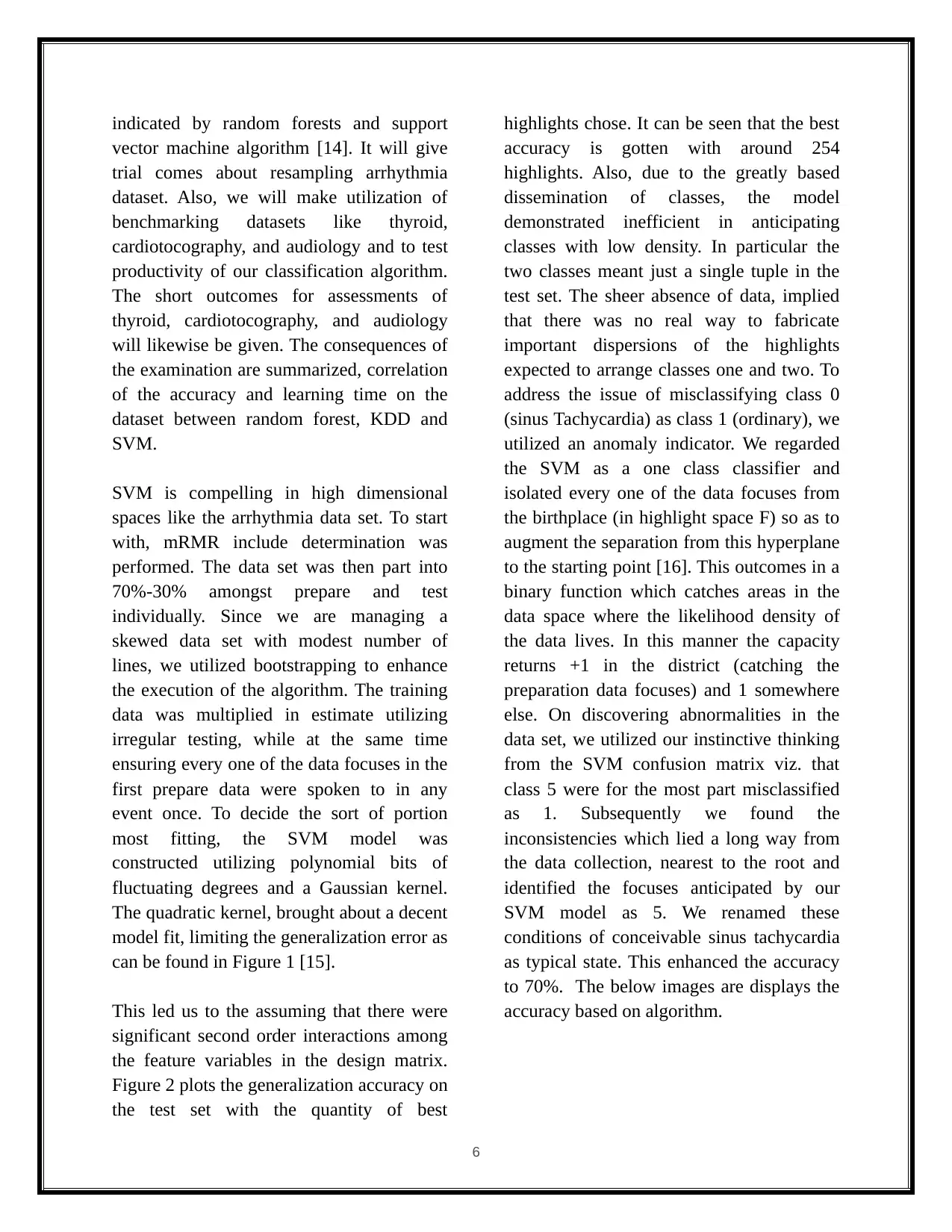
indicated by random forests and support
vector machine algorithm [14]. It will give
trial comes about resampling arrhythmia
dataset. Also, we will make utilization of
benchmarking datasets like thyroid,
cardiotocography, and audiology and to test
productivity of our classification algorithm.
The short outcomes for assessments of
thyroid, cardiotocography, and audiology
will likewise be given. The consequences of
the examination are summarized, correlation
of the accuracy and learning time on the
dataset between random forest, KDD and
SVM.
SVM is compelling in high dimensional
spaces like the arrhythmia data set. To start
with, mRMR include determination was
performed. The data set was then part into
70%-30% amongst prepare and test
individually. Since we are managing a
skewed data set with modest number of
lines, we utilized bootstrapping to enhance
the execution of the algorithm. The training
data was multiplied in estimate utilizing
irregular testing, while at the same time
ensuring every one of the data focuses in the
first prepare data were spoken to in any
event once. To decide the sort of portion
most fitting, the SVM model was
constructed utilizing polynomial bits of
fluctuating degrees and a Gaussian kernel.
The quadratic kernel, brought about a decent
model fit, limiting the generalization error as
can be found in Figure 1 [15].
This led us to the assuming that there were
significant second order interactions among
the feature variables in the design matrix.
Figure 2 plots the generalization accuracy on
the test set with the quantity of best
highlights chose. It can be seen that the best
accuracy is gotten with around 254
highlights. Also, due to the greatly based
dissemination of classes, the model
demonstrated inefficient in anticipating
classes with low density. In particular the
two classes meant just a single tuple in the
test set. The sheer absence of data, implied
that there was no real way to fabricate
important dispersions of the highlights
expected to arrange classes one and two. To
address the issue of misclassifying class 0
(sinus Tachycardia) as class 1 (ordinary), we
utilized an anomaly indicator. We regarded
the SVM as a one class classifier and
isolated every one of the data focuses from
the birthplace (in highlight space F) so as to
augment the separation from this hyperplane
to the starting point [16]. This outcomes in a
binary function which catches areas in the
data space where the likelihood density of
the data lives. In this manner the capacity
returns +1 in the district (catching the
preparation data focuses) and 1 somewhere
else. On discovering abnormalities in the
data set, we utilized our instinctive thinking
from the SVM confusion matrix viz. that
class 5 were for the most part misclassified
as 1. Subsequently we found the
inconsistencies which lied a long way from
the data collection, nearest to the root and
identified the focuses anticipated by our
SVM model as 5. We renamed these
conditions of conceivable sinus tachycardia
as typical state. This enhanced the accuracy
to 70%. The below images are displays the
accuracy based on algorithm.
6
vector machine algorithm [14]. It will give
trial comes about resampling arrhythmia
dataset. Also, we will make utilization of
benchmarking datasets like thyroid,
cardiotocography, and audiology and to test
productivity of our classification algorithm.
The short outcomes for assessments of
thyroid, cardiotocography, and audiology
will likewise be given. The consequences of
the examination are summarized, correlation
of the accuracy and learning time on the
dataset between random forest, KDD and
SVM.
SVM is compelling in high dimensional
spaces like the arrhythmia data set. To start
with, mRMR include determination was
performed. The data set was then part into
70%-30% amongst prepare and test
individually. Since we are managing a
skewed data set with modest number of
lines, we utilized bootstrapping to enhance
the execution of the algorithm. The training
data was multiplied in estimate utilizing
irregular testing, while at the same time
ensuring every one of the data focuses in the
first prepare data were spoken to in any
event once. To decide the sort of portion
most fitting, the SVM model was
constructed utilizing polynomial bits of
fluctuating degrees and a Gaussian kernel.
The quadratic kernel, brought about a decent
model fit, limiting the generalization error as
can be found in Figure 1 [15].
This led us to the assuming that there were
significant second order interactions among
the feature variables in the design matrix.
Figure 2 plots the generalization accuracy on
the test set with the quantity of best
highlights chose. It can be seen that the best
accuracy is gotten with around 254
highlights. Also, due to the greatly based
dissemination of classes, the model
demonstrated inefficient in anticipating
classes with low density. In particular the
two classes meant just a single tuple in the
test set. The sheer absence of data, implied
that there was no real way to fabricate
important dispersions of the highlights
expected to arrange classes one and two. To
address the issue of misclassifying class 0
(sinus Tachycardia) as class 1 (ordinary), we
utilized an anomaly indicator. We regarded
the SVM as a one class classifier and
isolated every one of the data focuses from
the birthplace (in highlight space F) so as to
augment the separation from this hyperplane
to the starting point [16]. This outcomes in a
binary function which catches areas in the
data space where the likelihood density of
the data lives. In this manner the capacity
returns +1 in the district (catching the
preparation data focuses) and 1 somewhere
else. On discovering abnormalities in the
data set, we utilized our instinctive thinking
from the SVM confusion matrix viz. that
class 5 were for the most part misclassified
as 1. Subsequently we found the
inconsistencies which lied a long way from
the data collection, nearest to the root and
identified the focuses anticipated by our
SVM model as 5. We renamed these
conditions of conceivable sinus tachycardia
as typical state. This enhanced the accuracy
to 70%. The below images are displays the
accuracy based on algorithm.
6
⊘ This is a preview!⊘
Do you want full access?
Subscribe today to unlock all pages.

Trusted by 1+ million students worldwide
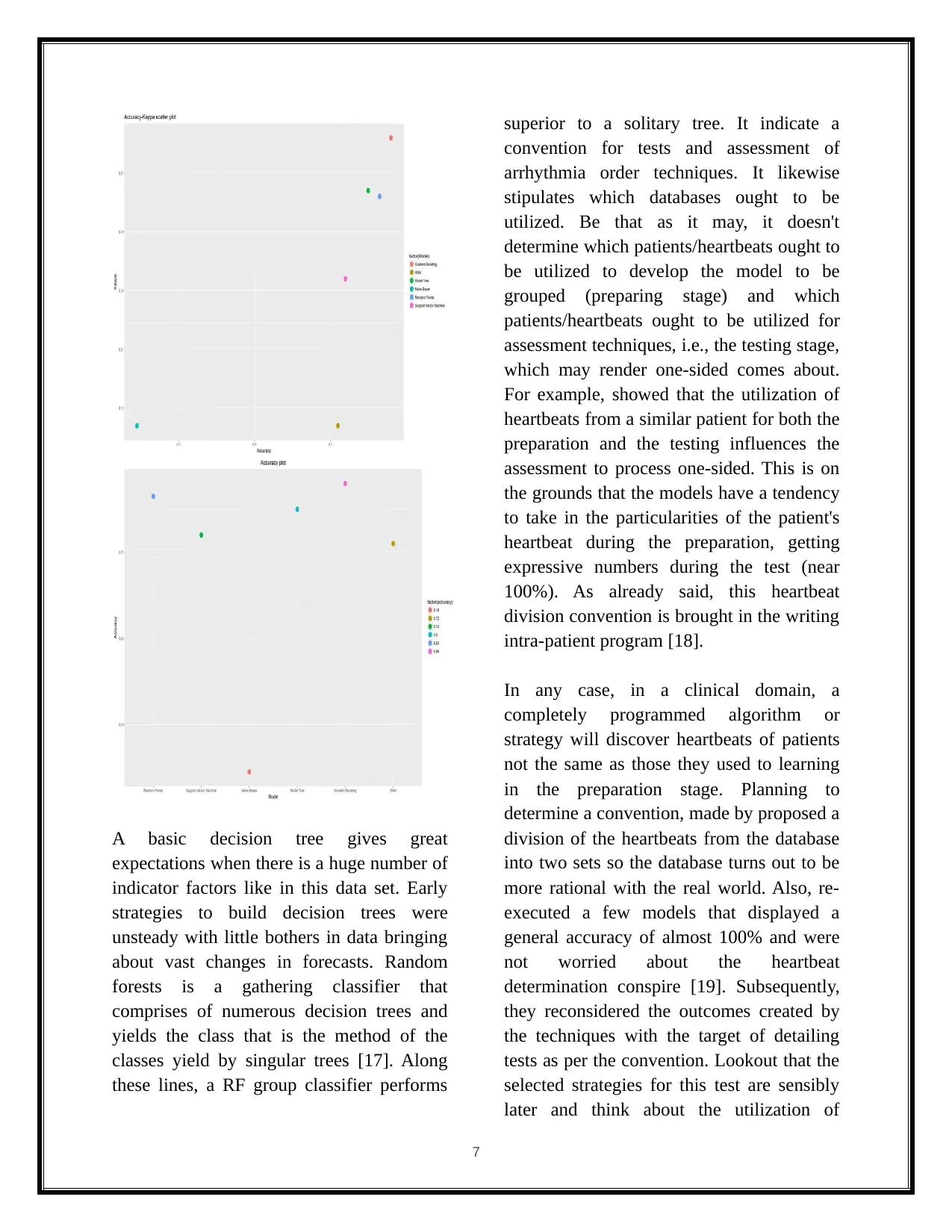
A basic decision tree gives great
expectations when there is a huge number of
indicator factors like in this data set. Early
strategies to build decision trees were
unsteady with little bothers in data bringing
about vast changes in forecasts. Random
forests is a gathering classifier that
comprises of numerous decision trees and
yields the class that is the method of the
classes yield by singular trees [17]. Along
these lines, a RF group classifier performs
superior to a solitary tree. It indicate a
convention for tests and assessment of
arrhythmia order techniques. It likewise
stipulates which databases ought to be
utilized. Be that as it may, it doesn't
determine which patients/heartbeats ought to
be utilized to develop the model to be
grouped (preparing stage) and which
patients/heartbeats ought to be utilized for
assessment techniques, i.e., the testing stage,
which may render one-sided comes about.
For example, showed that the utilization of
heartbeats from a similar patient for both the
preparation and the testing influences the
assessment to process one-sided. This is on
the grounds that the models have a tendency
to take in the particularities of the patient's
heartbeat during the preparation, getting
expressive numbers during the test (near
100%). As already said, this heartbeat
division convention is brought in the writing
intra-patient program [18].
In any case, in a clinical domain, a
completely programmed algorithm or
strategy will discover heartbeats of patients
not the same as those they used to learning
in the preparation stage. Planning to
determine a convention, made by proposed a
division of the heartbeats from the database
into two sets so the database turns out to be
more rational with the real world. Also, re-
executed a few models that displayed a
general accuracy of almost 100% and were
not worried about the heartbeat
determination conspire [19]. Subsequently,
they reconsidered the outcomes created by
the techniques with the target of detailing
tests as per the convention. Lookout that the
selected strategies for this test are sensibly
later and think about the utilization of
7
expectations when there is a huge number of
indicator factors like in this data set. Early
strategies to build decision trees were
unsteady with little bothers in data bringing
about vast changes in forecasts. Random
forests is a gathering classifier that
comprises of numerous decision trees and
yields the class that is the method of the
classes yield by singular trees [17]. Along
these lines, a RF group classifier performs
superior to a solitary tree. It indicate a
convention for tests and assessment of
arrhythmia order techniques. It likewise
stipulates which databases ought to be
utilized. Be that as it may, it doesn't
determine which patients/heartbeats ought to
be utilized to develop the model to be
grouped (preparing stage) and which
patients/heartbeats ought to be utilized for
assessment techniques, i.e., the testing stage,
which may render one-sided comes about.
For example, showed that the utilization of
heartbeats from a similar patient for both the
preparation and the testing influences the
assessment to process one-sided. This is on
the grounds that the models have a tendency
to take in the particularities of the patient's
heartbeat during the preparation, getting
expressive numbers during the test (near
100%). As already said, this heartbeat
division convention is brought in the writing
intra-patient program [18].
In any case, in a clinical domain, a
completely programmed algorithm or
strategy will discover heartbeats of patients
not the same as those they used to learning
in the preparation stage. Planning to
determine a convention, made by proposed a
division of the heartbeats from the database
into two sets so the database turns out to be
more rational with the real world. Also, re-
executed a few models that displayed a
general accuracy of almost 100% and were
not worried about the heartbeat
determination conspire [19]. Subsequently,
they reconsidered the outcomes created by
the techniques with the target of detailing
tests as per the convention. Lookout that the
selected strategies for this test are sensibly
later and think about the utilization of
7
Paraphrase This Document
Need a fresh take? Get an instant paraphrase of this document with our AI Paraphraser
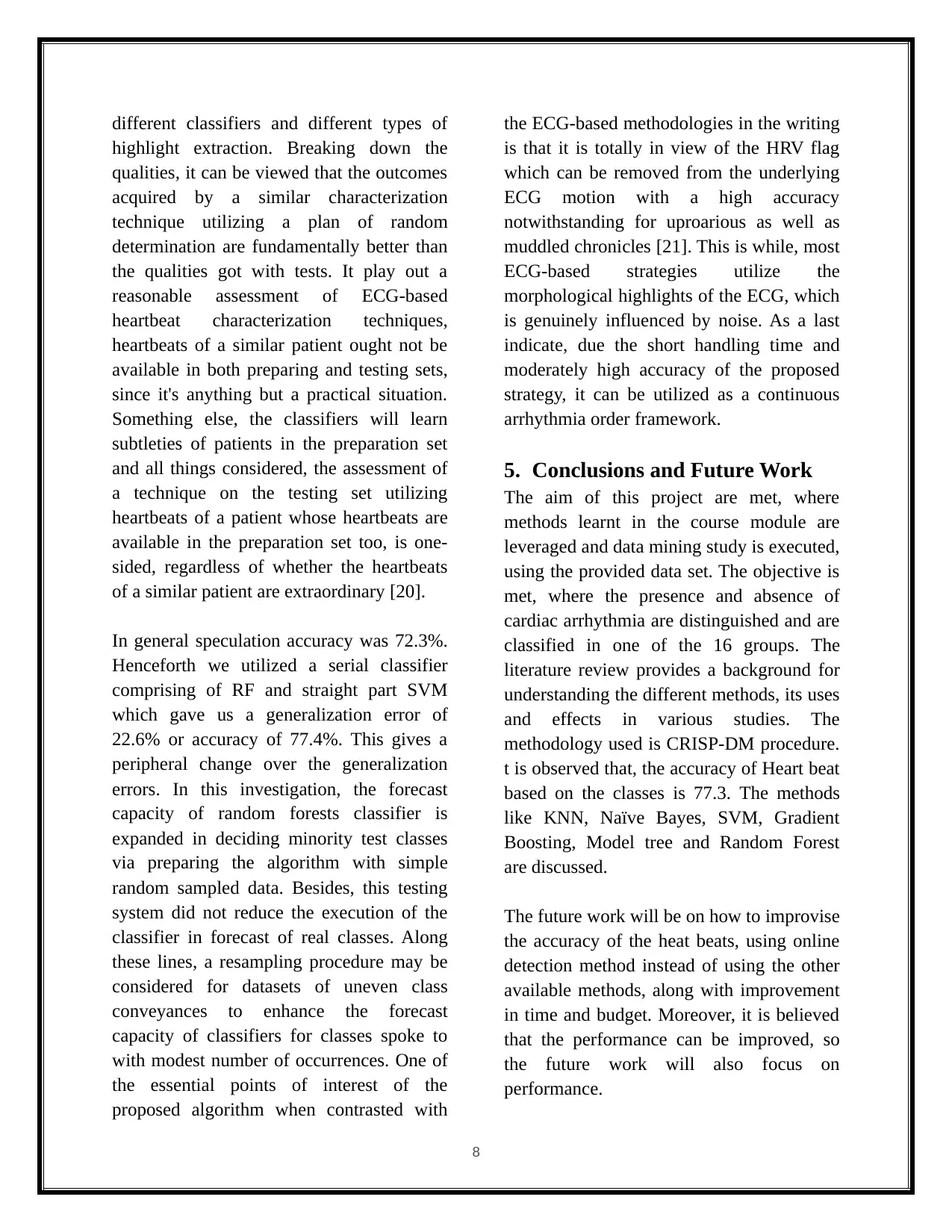
different classifiers and different types of
highlight extraction. Breaking down the
qualities, it can be viewed that the outcomes
acquired by a similar characterization
technique utilizing a plan of random
determination are fundamentally better than
the qualities got with tests. It play out a
reasonable assessment of ECG-based
heartbeat characterization techniques,
heartbeats of a similar patient ought not be
available in both preparing and testing sets,
since it's anything but a practical situation.
Something else, the classifiers will learn
subtleties of patients in the preparation set
and all things considered, the assessment of
a technique on the testing set utilizing
heartbeats of a patient whose heartbeats are
available in the preparation set too, is one-
sided, regardless of whether the heartbeats
of a similar patient are extraordinary [20].
In general speculation accuracy was 72.3%.
Henceforth we utilized a serial classifier
comprising of RF and straight part SVM
which gave us a generalization error of
22.6% or accuracy of 77.4%. This gives a
peripheral change over the generalization
errors. In this investigation, the forecast
capacity of random forests classifier is
expanded in deciding minority test classes
via preparing the algorithm with simple
random sampled data. Besides, this testing
system did not reduce the execution of the
classifier in forecast of real classes. Along
these lines, a resampling procedure may be
considered for datasets of uneven class
conveyances to enhance the forecast
capacity of classifiers for classes spoke to
with modest number of occurrences. One of
the essential points of interest of the
proposed algorithm when contrasted with
the ECG-based methodologies in the writing
is that it is totally in view of the HRV flag
which can be removed from the underlying
ECG motion with a high accuracy
notwithstanding for uproarious as well as
muddled chronicles [21]. This is while, most
ECG-based strategies utilize the
morphological highlights of the ECG, which
is genuinely influenced by noise. As a last
indicate, due the short handling time and
moderately high accuracy of the proposed
strategy, it can be utilized as a continuous
arrhythmia order framework.
5. Conclusions and Future Work
The aim of this project are met, where
methods learnt in the course module are
leveraged and data mining study is executed,
using the provided data set. The objective is
met, where the presence and absence of
cardiac arrhythmia are distinguished and are
classified in one of the 16 groups. The
literature review provides a background for
understanding the different methods, its uses
and effects in various studies. The
methodology used is CRISP-DM procedure.
t is observed that, the accuracy of Heart beat
based on the classes is 77.3. The methods
like KNN, Naïve Bayes, SVM, Gradient
Boosting, Model tree and Random Forest
are discussed.
The future work will be on how to improvise
the accuracy of the heat beats, using online
detection method instead of using the other
available methods, along with improvement
in time and budget. Moreover, it is believed
that the performance can be improved, so
the future work will also focus on
performance.
8
highlight extraction. Breaking down the
qualities, it can be viewed that the outcomes
acquired by a similar characterization
technique utilizing a plan of random
determination are fundamentally better than
the qualities got with tests. It play out a
reasonable assessment of ECG-based
heartbeat characterization techniques,
heartbeats of a similar patient ought not be
available in both preparing and testing sets,
since it's anything but a practical situation.
Something else, the classifiers will learn
subtleties of patients in the preparation set
and all things considered, the assessment of
a technique on the testing set utilizing
heartbeats of a patient whose heartbeats are
available in the preparation set too, is one-
sided, regardless of whether the heartbeats
of a similar patient are extraordinary [20].
In general speculation accuracy was 72.3%.
Henceforth we utilized a serial classifier
comprising of RF and straight part SVM
which gave us a generalization error of
22.6% or accuracy of 77.4%. This gives a
peripheral change over the generalization
errors. In this investigation, the forecast
capacity of random forests classifier is
expanded in deciding minority test classes
via preparing the algorithm with simple
random sampled data. Besides, this testing
system did not reduce the execution of the
classifier in forecast of real classes. Along
these lines, a resampling procedure may be
considered for datasets of uneven class
conveyances to enhance the forecast
capacity of classifiers for classes spoke to
with modest number of occurrences. One of
the essential points of interest of the
proposed algorithm when contrasted with
the ECG-based methodologies in the writing
is that it is totally in view of the HRV flag
which can be removed from the underlying
ECG motion with a high accuracy
notwithstanding for uproarious as well as
muddled chronicles [21]. This is while, most
ECG-based strategies utilize the
morphological highlights of the ECG, which
is genuinely influenced by noise. As a last
indicate, due the short handling time and
moderately high accuracy of the proposed
strategy, it can be utilized as a continuous
arrhythmia order framework.
5. Conclusions and Future Work
The aim of this project are met, where
methods learnt in the course module are
leveraged and data mining study is executed,
using the provided data set. The objective is
met, where the presence and absence of
cardiac arrhythmia are distinguished and are
classified in one of the 16 groups. The
literature review provides a background for
understanding the different methods, its uses
and effects in various studies. The
methodology used is CRISP-DM procedure.
t is observed that, the accuracy of Heart beat
based on the classes is 77.3. The methods
like KNN, Naïve Bayes, SVM, Gradient
Boosting, Model tree and Random Forest
are discussed.
The future work will be on how to improvise
the accuracy of the heat beats, using online
detection method instead of using the other
available methods, along with improvement
in time and budget. Moreover, it is believed
that the performance can be improved, so
the future work will also focus on
performance.
8
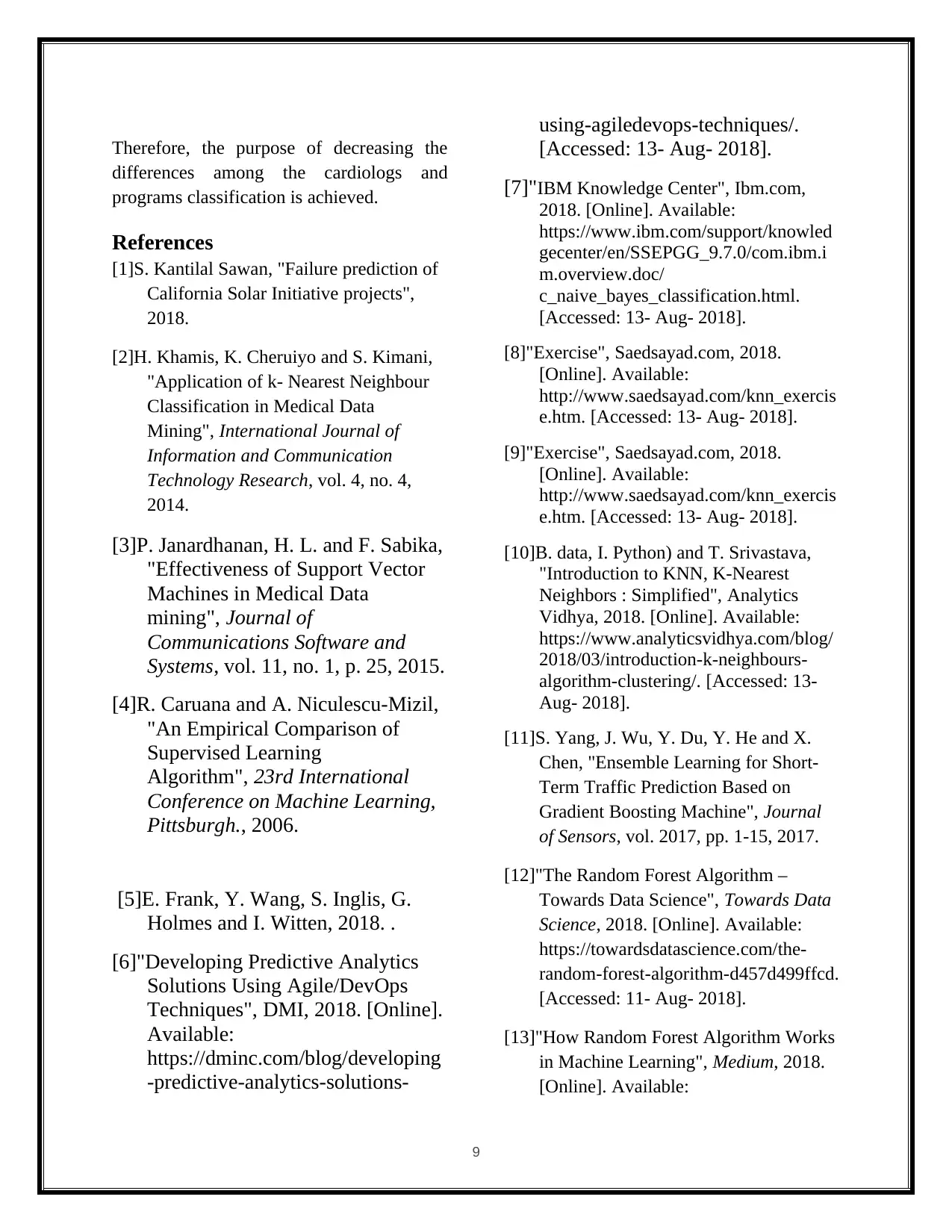
Therefore, the purpose of decreasing the
differences among the cardiologs and
programs classification is achieved.
References
[1]S. Kantilal Sawan, "Failure prediction of
California Solar Initiative projects",
2018.
[2]H. Khamis, K. Cheruiyo and S. Kimani,
"Application of k- Nearest Neighbour
Classification in Medical Data
Mining", International Journal of
Information and Communication
Technology Research, vol. 4, no. 4,
2014.
[3]P. Janardhanan, H. L. and F. Sabika,
"Effectiveness of Support Vector
Machines in Medical Data
mining", Journal of
Communications Software and
Systems, vol. 11, no. 1, p. 25, 2015.
[4]R. Caruana and A. Niculescu-Mizil,
"An Empirical Comparison of
Supervised Learning
Algorithm", 23rd International
Conference on Machine Learning,
Pittsburgh., 2006.
[5]E. Frank, Y. Wang, S. Inglis, G.
Holmes and I. Witten, 2018. .
[6]"Developing Predictive Analytics
Solutions Using Agile/DevOps
Techniques", DMI, 2018. [Online].
Available:
https://dminc.com/blog/developing
-predictive-analytics-solutions-
using-agiledevops-techniques/.
[Accessed: 13- Aug- 2018].
[7]"IBM Knowledge Center", Ibm.com,
2018. [Online]. Available:
https://www.ibm.com/support/knowled
gecenter/en/SSEPGG_9.7.0/com.ibm.i
m.overview.doc/
c_naive_bayes_classification.html.
[Accessed: 13- Aug- 2018].
[8]"Exercise", Saedsayad.com, 2018.
[Online]. Available:
http://www.saedsayad.com/knn_exercis
e.htm. [Accessed: 13- Aug- 2018].
[9]"Exercise", Saedsayad.com, 2018.
[Online]. Available:
http://www.saedsayad.com/knn_exercis
e.htm. [Accessed: 13- Aug- 2018].
[10]B. data, I. Python) and T. Srivastava,
"Introduction to KNN, K-Nearest
Neighbors : Simplified", Analytics
Vidhya, 2018. [Online]. Available:
https://www.analyticsvidhya.com/blog/
2018/03/introduction-k-neighbours-
algorithm-clustering/. [Accessed: 13-
Aug- 2018].
[11]S. Yang, J. Wu, Y. Du, Y. He and X.
Chen, "Ensemble Learning for Short-
Term Traffic Prediction Based on
Gradient Boosting Machine", Journal
of Sensors, vol. 2017, pp. 1-15, 2017.
[12]"The Random Forest Algorithm –
Towards Data Science", Towards Data
Science, 2018. [Online]. Available:
https://towardsdatascience.com/the-
random-forest-algorithm-d457d499ffcd.
[Accessed: 11- Aug- 2018].
[13]"How Random Forest Algorithm Works
in Machine Learning", Medium, 2018.
[Online]. Available:
9
differences among the cardiologs and
programs classification is achieved.
References
[1]S. Kantilal Sawan, "Failure prediction of
California Solar Initiative projects",
2018.
[2]H. Khamis, K. Cheruiyo and S. Kimani,
"Application of k- Nearest Neighbour
Classification in Medical Data
Mining", International Journal of
Information and Communication
Technology Research, vol. 4, no. 4,
2014.
[3]P. Janardhanan, H. L. and F. Sabika,
"Effectiveness of Support Vector
Machines in Medical Data
mining", Journal of
Communications Software and
Systems, vol. 11, no. 1, p. 25, 2015.
[4]R. Caruana and A. Niculescu-Mizil,
"An Empirical Comparison of
Supervised Learning
Algorithm", 23rd International
Conference on Machine Learning,
Pittsburgh., 2006.
[5]E. Frank, Y. Wang, S. Inglis, G.
Holmes and I. Witten, 2018. .
[6]"Developing Predictive Analytics
Solutions Using Agile/DevOps
Techniques", DMI, 2018. [Online].
Available:
https://dminc.com/blog/developing
-predictive-analytics-solutions-
using-agiledevops-techniques/.
[Accessed: 13- Aug- 2018].
[7]"IBM Knowledge Center", Ibm.com,
2018. [Online]. Available:
https://www.ibm.com/support/knowled
gecenter/en/SSEPGG_9.7.0/com.ibm.i
m.overview.doc/
c_naive_bayes_classification.html.
[Accessed: 13- Aug- 2018].
[8]"Exercise", Saedsayad.com, 2018.
[Online]. Available:
http://www.saedsayad.com/knn_exercis
e.htm. [Accessed: 13- Aug- 2018].
[9]"Exercise", Saedsayad.com, 2018.
[Online]. Available:
http://www.saedsayad.com/knn_exercis
e.htm. [Accessed: 13- Aug- 2018].
[10]B. data, I. Python) and T. Srivastava,
"Introduction to KNN, K-Nearest
Neighbors : Simplified", Analytics
Vidhya, 2018. [Online]. Available:
https://www.analyticsvidhya.com/blog/
2018/03/introduction-k-neighbours-
algorithm-clustering/. [Accessed: 13-
Aug- 2018].
[11]S. Yang, J. Wu, Y. Du, Y. He and X.
Chen, "Ensemble Learning for Short-
Term Traffic Prediction Based on
Gradient Boosting Machine", Journal
of Sensors, vol. 2017, pp. 1-15, 2017.
[12]"The Random Forest Algorithm –
Towards Data Science", Towards Data
Science, 2018. [Online]. Available:
https://towardsdatascience.com/the-
random-forest-algorithm-d457d499ffcd.
[Accessed: 11- Aug- 2018].
[13]"How Random Forest Algorithm Works
in Machine Learning", Medium, 2018.
[Online]. Available:
9
⊘ This is a preview!⊘
Do you want full access?
Subscribe today to unlock all pages.

Trusted by 1+ million students worldwide
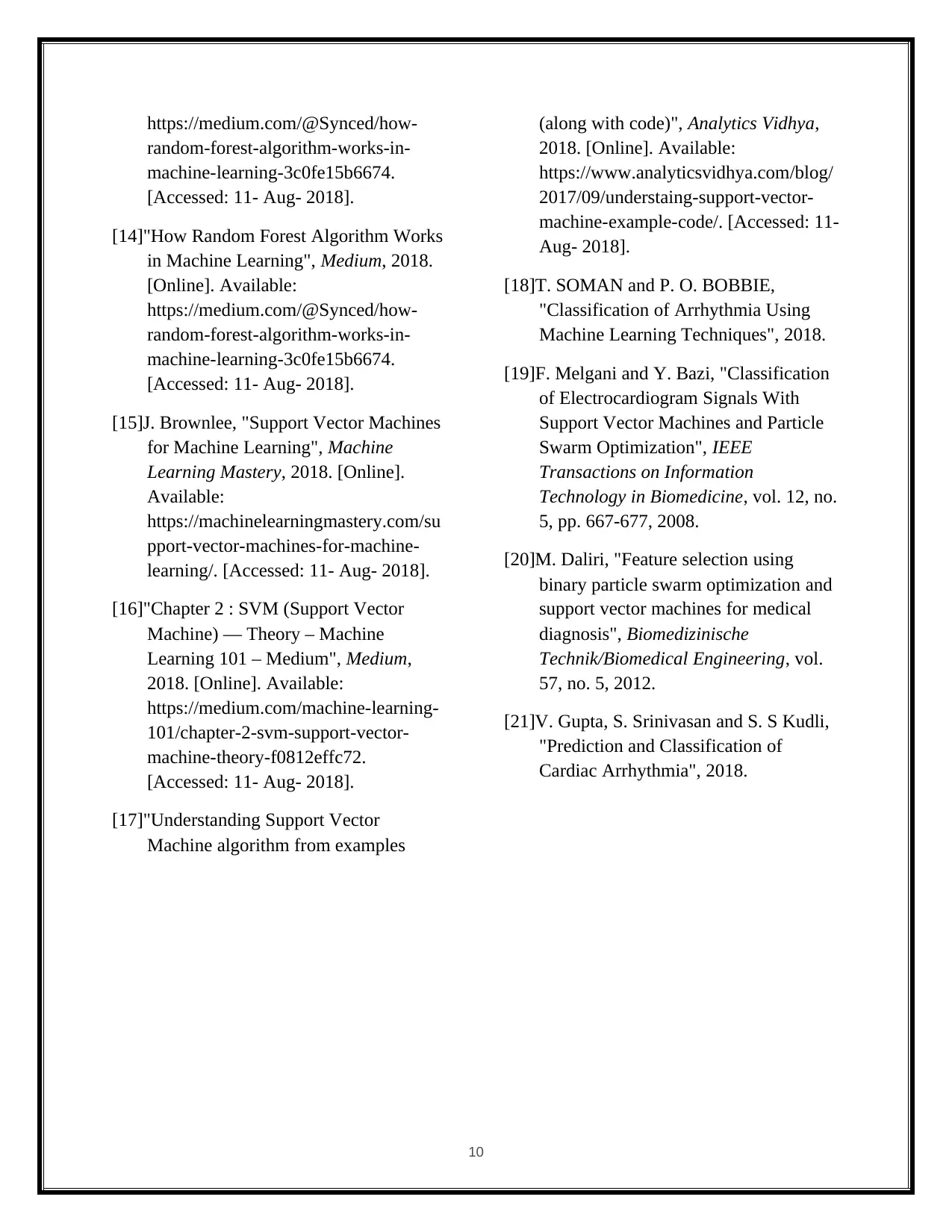
https://medium.com/@Synced/how-
random-forest-algorithm-works-in-
machine-learning-3c0fe15b6674.
[Accessed: 11- Aug- 2018].
[14]"How Random Forest Algorithm Works
in Machine Learning", Medium, 2018.
[Online]. Available:
https://medium.com/@Synced/how-
random-forest-algorithm-works-in-
machine-learning-3c0fe15b6674.
[Accessed: 11- Aug- 2018].
[15]J. Brownlee, "Support Vector Machines
for Machine Learning", Machine
Learning Mastery, 2018. [Online].
Available:
https://machinelearningmastery.com/su
pport-vector-machines-for-machine-
learning/. [Accessed: 11- Aug- 2018].
[16]"Chapter 2 : SVM (Support Vector
Machine) — Theory – Machine
Learning 101 – Medium", Medium,
2018. [Online]. Available:
https://medium.com/machine-learning-
101/chapter-2-svm-support-vector-
machine-theory-f0812effc72.
[Accessed: 11- Aug- 2018].
[17]"Understanding Support Vector
Machine algorithm from examples
(along with code)", Analytics Vidhya,
2018. [Online]. Available:
https://www.analyticsvidhya.com/blog/
2017/09/understaing-support-vector-
machine-example-code/. [Accessed: 11-
Aug- 2018].
[18]T. SOMAN and P. O. BOBBIE,
"Classification of Arrhythmia Using
Machine Learning Techniques", 2018.
[19]F. Melgani and Y. Bazi, "Classification
of Electrocardiogram Signals With
Support Vector Machines and Particle
Swarm Optimization", IEEE
Transactions on Information
Technology in Biomedicine, vol. 12, no.
5, pp. 667-677, 2008.
[20]M. Daliri, "Feature selection using
binary particle swarm optimization and
support vector machines for medical
diagnosis", Biomedizinische
Technik/Biomedical Engineering, vol.
57, no. 5, 2012.
[21]V. Gupta, S. Srinivasan and S. S Kudli,
"Prediction and Classification of
Cardiac Arrhythmia", 2018.
10
random-forest-algorithm-works-in-
machine-learning-3c0fe15b6674.
[Accessed: 11- Aug- 2018].
[14]"How Random Forest Algorithm Works
in Machine Learning", Medium, 2018.
[Online]. Available:
https://medium.com/@Synced/how-
random-forest-algorithm-works-in-
machine-learning-3c0fe15b6674.
[Accessed: 11- Aug- 2018].
[15]J. Brownlee, "Support Vector Machines
for Machine Learning", Machine
Learning Mastery, 2018. [Online].
Available:
https://machinelearningmastery.com/su
pport-vector-machines-for-machine-
learning/. [Accessed: 11- Aug- 2018].
[16]"Chapter 2 : SVM (Support Vector
Machine) — Theory – Machine
Learning 101 – Medium", Medium,
2018. [Online]. Available:
https://medium.com/machine-learning-
101/chapter-2-svm-support-vector-
machine-theory-f0812effc72.
[Accessed: 11- Aug- 2018].
[17]"Understanding Support Vector
Machine algorithm from examples
(along with code)", Analytics Vidhya,
2018. [Online]. Available:
https://www.analyticsvidhya.com/blog/
2017/09/understaing-support-vector-
machine-example-code/. [Accessed: 11-
Aug- 2018].
[18]T. SOMAN and P. O. BOBBIE,
"Classification of Arrhythmia Using
Machine Learning Techniques", 2018.
[19]F. Melgani and Y. Bazi, "Classification
of Electrocardiogram Signals With
Support Vector Machines and Particle
Swarm Optimization", IEEE
Transactions on Information
Technology in Biomedicine, vol. 12, no.
5, pp. 667-677, 2008.
[20]M. Daliri, "Feature selection using
binary particle swarm optimization and
support vector machines for medical
diagnosis", Biomedizinische
Technik/Biomedical Engineering, vol.
57, no. 5, 2012.
[21]V. Gupta, S. Srinivasan and S. S Kudli,
"Prediction and Classification of
Cardiac Arrhythmia", 2018.
10
1 out of 10
Your All-in-One AI-Powered Toolkit for Academic Success.
+13062052269
info@desklib.com
Available 24*7 on WhatsApp / Email
![[object Object]](/_next/static/media/star-bottom.7253800d.svg)
Unlock your academic potential
Copyright © 2020–2025 A2Z Services. All Rights Reserved. Developed and managed by ZUCOL.
